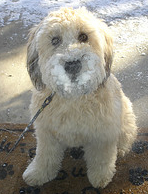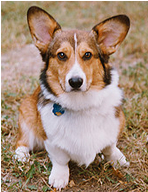
Dogs
With its adorable wrinkles, the Chinese shar-pei is a well-recognized and popular dog. But politics and ideology would have driven the dog to extinction without the intervention of one man in Hong Kong.
The shar-pei is an ancient and unique breed, existing for centuries in the southern provinces of China in Kwan-Tung. It is likely that the breed has been around since the Han dynasty (202 b.c. – 220 a.d.)
Originally recognized as a fighting breed, the shar-pei has also been used for hunting, herding and protection. The term shar-pei translates to "harsh sandy coat" or "sandpaper-like coat" in reference to the bristly feeling of the breed's coat.
After the Communists took power in China, dogs were virtually eliminated. Since dogs were previously owned by wealthy individuals, they were thought to be reminders of an elite class that no longer existed. The act of owning a dog under the new Communist regime invited severe penalties.
Thankfully, owing primarily to the efforts of Mr. Matgo Law of Hong Kong (which was a colony of Great Britain at the time), a few shar-peis were imported to Hong Kong and Taiwan. From there, breeding continued and the breed flourished. By 1968, the shar-pei was recognized by the Hong Kong Kennel Club.
The breed first appeared in the United States in 1966 and was eventually accepting into the American Kennel Club in 1988 as a member of the non-sporting group.
The shar-pei is easily recognized by their loose wrinkly skin. More profound as puppies, most adult shar-peis still retain many wrinkles. Since the dog was originally bred for fighting, the loose skin allowed a shar-pei to turn around and continue to fight if held in another dog's grip.
There are two distinctive types of shar-pei hair coats, both short and harsh. The short coated version is referred to as "horse" coated. The longer coated version, though less than 1 inch in length, is referred to as "brush" coated. The most common coat colors are fawn, black, cream, red, chocolate, sable and silver.
In addition to distinctive wrinkles, the shar-pei is one of the rare breeds with a blue black tongue. The head is large with a muzzle shape and padded lips reminiscent of a hippopotamus. The ears are small, drooping and close to the head. The tail is carried high and curled over the back in a tight or loose curl.
The shar-pei stands about 18 to 20 inches from the ground to the top of the shoulder. An adult shar-pei weighs about 45 to 55 pounds.
The shar-pei is known to have a strong personality and dominant temperament. They tend to be quite active and need plenty of exercise. The breed is dignified and compact and tends to be somewhat snobbish. They enjoy their freedom and do well in the country or city but do not kennel well.
The shar-pei is an independent dog and a little standoffish but a very devoted and protective family member. They are one of the easiest breeds to house train. Due to the independent nature, the shar-pei prefers to be in a one-dog family. Despite being cute and adorable as puppies, the breed is not recommended for families with young children.
In years past, the shar-pei was inclined to be sharp and unmanageable. After much work by breeders, today's breed is significantly less aggressive and more manageable. Despite this, the breed does need a firm hand and early socialization.
The shar-pei is intelligent but can be stubborn. As natural family protectors, the shar-pei is a good watchdog.
The shar-pei can be aggressive toward strangers and does not have the necessary patience to handle the antics of children. The dog prefers to be king or queen of the house. For this reason, it is crucial for owners to establish themselves as the household leader early in the dog's life.
 Tibetan Terriers: A guide to dogs and puppies of the Tibetan Terrier breed
The Tibetan Terrier!
The Tibetan Terrier looks like a sheep
Tibetan Terriers: A guide to dogs and puppies of the Tibetan Terrier breed
The Tibetan Terrier!
The Tibetan Terrier looks like a sheep
 Soft Coated Wheaten Terriers: A guide to dogs and puppies of the Soft Coated Wheaten Terrier breed
The Soft Coated Wheaten Terrier!
The Soft Coated Wheaten Te
Soft Coated Wheaten Terriers: A guide to dogs and puppies of the Soft Coated Wheaten Terrier breed
The Soft Coated Wheaten Terrier!
The Soft Coated Wheaten Te
 Rhodesian Ridgebacks: A guide to dogs and puppies of the Rhodesian Ridgeback breed
The Rhodesian Ridgeback!
The Rhodesian Ridgeback is so name
Rhodesian Ridgebacks: A guide to dogs and puppies of the Rhodesian Ridgeback breed
The Rhodesian Ridgeback!
The Rhodesian Ridgeback is so name
 Welsh Corgi (Pembroke)
Welsh Corgi (P
Welsh Corgi (Pembroke)
Welsh Corgi (P
 Pembroke Welsh Corgis: A guide to dogs and puppies of the Pembroke Welsh Corgi breed
The Pembroke Welsh Corgi!
The Pembroke Welsh Corgi is a bre
Pembroke Welsh Corgis: A guide to dogs and puppies of the Pembroke Welsh Corgi breed
The Pembroke Welsh Corgi!
The Pembroke Welsh Corgi is a bre
Copyright © 2005-2016 Pet Information All Rights Reserved
Contact us: www162date@outlook.com